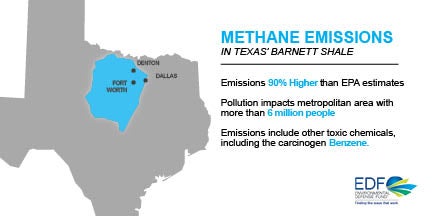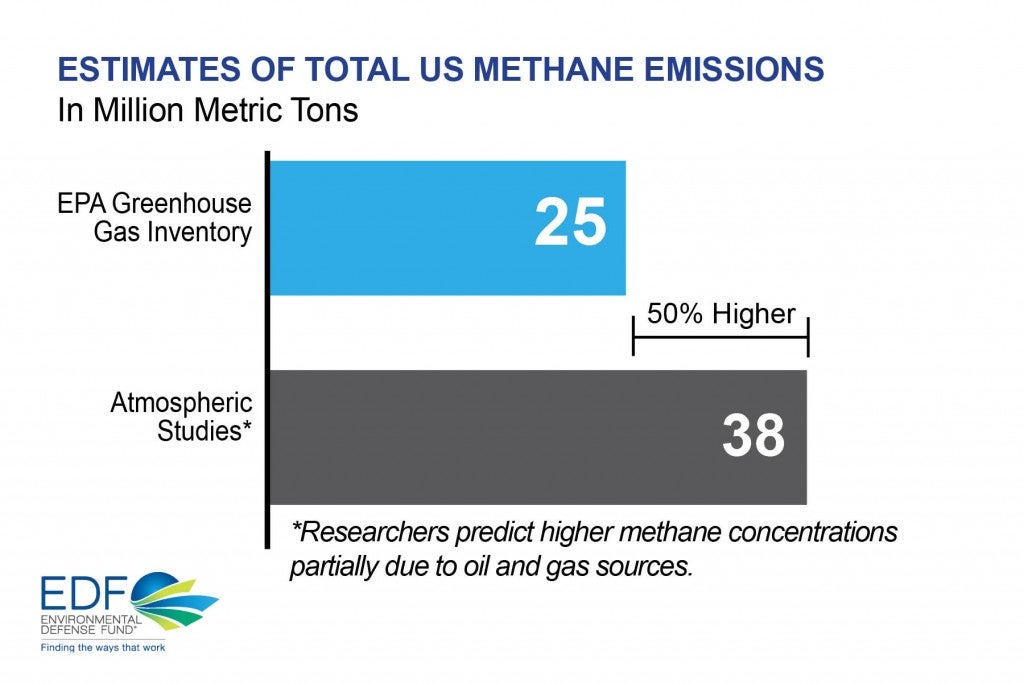Page added on December 9, 2015
New Study Finds Oil and Gas Methane Emissions in the Barnett Shale Twice Official Estimates

 A new scientific study published recently in the Proceedings of the National Academy of Sciences, coordinated by EDF, reports findings from the most comprehensive examination of regional methane emissions completed to date. Focused on Texas’ Barnett Shale – one of the nation’s major oil-and-gas-producing regions – the study uses a new, more accurate way to determine the total amount of methane escaping into the atmosphere from the region’s oil and gas production, processing and transportation.
A new scientific study published recently in the Proceedings of the National Academy of Sciences, coordinated by EDF, reports findings from the most comprehensive examination of regional methane emissions completed to date. Focused on Texas’ Barnett Shale – one of the nation’s major oil-and-gas-producing regions – the study uses a new, more accurate way to determine the total amount of methane escaping into the atmosphere from the region’s oil and gas production, processing and transportation.
The result is that methane emissions in the Barnett Shale are 90 percent higher than EPA’s inventory data would suggest.
This is just one of several recent studies showing a pattern of underestimating methane emissions in locations across the country. One big reason is that conventional inventories typically fail to accurately account for very large, unpredictable emissions from leaks, malfunctions or other problems. In the Barnett study, these were the source of a large share of total emissions.
Why Methane Matters
The higher emissions rate and the agreement among measurement methods represent an important step forward in our understanding of what it will take to mitigate those emissions. Methane is the main ingredient in natural gas, and a highly potent greenhouse gas, with over 80 times the 20-year warming power of carbon dioxide.
When methane leaks, the climate impact of using natural gas increases. In the case of Barnett Shale gas, based on emissions identified in the study, the climate impact is 50 percent higher over 20 years as compared to the use of natural gas in the absence of any emissions.
//www.youtube.com/watch?v=traRDCjwqc8
Getting the Full Picture
The study analyzes data from 12 papers that were published earlier this year as part of an extensive, coordinated effort among more than 10 research teams to quantify oil and gas methane emissions at a regional scale. It affirms the importance of earlier findings that the biggest emissions come from a relatively small number of unpredictable sources that are inherently difficult to anticipate.
For example, in the instance of production sites, 30 percent of those in the Barnett Shale region leak more than 1 percent of the natural gas they produce, which in turn accounts for 70 percent of overall production site emissions. This suggests that frequent and thorough inspection and repair efforts are necessary to find and eliminate methane leaks as they arise.
 In this study, scientists compiled an updated, comprehensive inventory of emissions sources from across the oil and gas supply chain, and multiple research teams deployed a diversity of measurement techniques to reconcile the differences between emission rates estimated using airborne (top-down) and ground-based (bottom-up) methodologies that have previously been observed. That means scientists, policymakers and companies can now have greater certainty about methane emission rates not only in the Barnett, but also have proven methodologies that can be used to get a clear picture of emissions elsewhere.
In this study, scientists compiled an updated, comprehensive inventory of emissions sources from across the oil and gas supply chain, and multiple research teams deployed a diversity of measurement techniques to reconcile the differences between emission rates estimated using airborne (top-down) and ground-based (bottom-up) methodologies that have previously been observed. That means scientists, policymakers and companies can now have greater certainty about methane emission rates not only in the Barnett, but also have proven methodologies that can be used to get a clear picture of emissions elsewhere.
Live case in point in California
A real-life example of just how important high-emitting sources can be is taking place in California right now at the Aliso Canyon natural gas storage facility owned by Southern California Gas. For over a month, a massive leak has been pumping out about 50,000 kilograms of methane an hour – more than a quarter of the state’s estimated daily total methane emissions.
Circumstances at the aging gas storage facility – where the company pumps natural gas back underground into an old oil deposit for times when it is needed – are unique. But while extreme, it is an example of the kind of large, unpredictable leaks that occur daily throughout the oil and gas supply chain.
Based on the new research just reported as well as other studies that have taken account of super emitters, EPA’s already large national estimate of 7.3 million tons of yearly methane emissions from the oil and gas industry could be much higher (and that doesn’t even include emissions from major malfunctions like the one in California).
Addressing the Problem
Policymakers increasingly recognize the importance of better oversight of oil and gas methane emissions. In fact, the Environmental Protection Agency (EPA) recently proposed the first-ever national standards for this pollutant from new and modified oil and gas sources. Findings from this new research characterizing methane emissions in the Barnett region can help inform EPA’s rulemaking – for example, the research indicates that strong leak detection and repair requirements are critical to quickly finding high emitting sources and getting them repaired.
But most importantly, the research shows the increasing confidence we now have in dealing with a methane problem bigger than previously recognized, and that means EPA’s work is not yet over. Once a strong set of rules is created for mitigating methane emissions from new and modified sources, EPA needs to address emissions from existing sources that will still be contributing the overwhelming majority of emissions in the coming years. And, as seen in the Barnett Shale region of Texas, where the true scale of the existing problem is now well defined, that will be a significant amount.
As the measurement methods that were validated in the the Barnett research are applied in other regions across the U.S. – and the world – they will provide a much clearer picture of the state of oil and gas methane emissions, and how to best address them.
13 Comments on "New Study Finds Oil and Gas Methane Emissions in the Barnett Shale Twice Official Estimates"


makati1 on Wed, 9th Dec 2015 7:16 pm
You pay … and then you pay again … and again … and again …
This time the bill will come due when temperatures reach a point where they cannot be ignored or covered up. That date is fast approaching. 100 years? Maybe 10, if we are lucky.
shortonoil on Wed, 9th Dec 2015 7:27 pm
Houston! We have a problem
Boat on Wed, 9th Dec 2015 7:38 pm
Yes gasoline down to $1.64 per gal in Houston. Short says that’s depletion at work. Let’s throw in drop in quality of the oil.
The glut has nothing to do with oil around the world being produced at a lower price even when consumption is rising. LOL
Hey apeman,
Blue Bell has pistachio back.
apneaman on Wed, 9th Dec 2015 7:56 pm
Boat, I understand Blue Bell has had some quality control/poison issues lately. Apparently all Texas companies are fuck ups and liars so you go right ahead and fill your boots. Besides they don’t sell that brand up here.
Boat on Wed, 9th Dec 2015 8:05 pm
apeman,
Only a few died but were used to that in the US. Blue Bell is a more expensive creamy tasting ice cream. After shutting down production for awhile, trucks started rolling back in Houston a couple months age. There were lines blocks long at outlets waiting for their fix. Pasticho may bring me back.
apneaman on Wed, 9th Dec 2015 8:12 pm
More die every month or so now from the AGW jacked deluges. Got to get use to it. I had plenty of Blue Bell when I was in Georgia.
rockman on Thu, 10th Dec 2015 6:37 am
I can’t find details of this particular analysis but I suspect it fails as most survey have in the past. They don’t test for leaks at the wellhead…the run regional air surveys. The problem there is that areas with large oil/NG accumulations tend to have a significant natural leakage coming directly from the ground. In fact there are service companies that the industry PAYS to make such airborne surveys as a regional exploration tool. The Rockman has conducted several such surveys in the last 40 years. I’ve actually once mapped the surface cut of a fault about 100 miles from the Barnett Shale trend based upon natural methane leaks. I would be surprised if most/all of such studies reporting significant ATMOSHERIC levels of methane didn’t use the same oil patch service companies to generate their data base.
Which isn’t to say there’s no leakage from the industry’s production effort. The question is the magnitude. But why not test at the well head instead of doing obviously flawed regional analysis? They been doing such analysis in cities checking for leaks from the residential pipeline systems. There’s growing evidence that the great majority of methane leaks in the US is coming from those systems and not production operations. Consider this analysis of one of the cities that like to tout itself as environmentally friendly and “green”…Boston:
“One of the nation’s oldest major cities, Boston’s aging natural gas pipes are prone to corrosion and leaks. How many leaks: Our readings indicated an average of about one leak for each mile we drove. We mapped areas serviced by National Grid, a shareholder owned gas and electric company serving areas of New York, Rhode Island, and Massachusetts, which provides gas to most of Boston. Nearly 45% of the pipes are made from cast iron or other corrosive and leak-prone materials. More than half of the pipes are more than 50 years old. Cars with air sensors took readings from March through June 2013. In June 2014, Governor Patrick signed a strong bill to accelerate detection and repair of leaks that pose safety threats.“
{So even the state’s govt recognizes that Boston is a significant emitter of a significant GHG.}
kanon on Thu, 10th Dec 2015 8:50 am
rockman: “There’s growing evidence that the great majority of methane leaks in the US is coming from those systems and not production operations.”
Excellent point. Who would have thought the plumbing could be leaking? But I don’t like the idea of exonerating the fracking operators, since I think that over time all the groundwater in the Barnett Shale region will become contaminated with fracking chemicals and NG seeps.
PeakOiler on Thu, 10th Dec 2015 11:11 am
None of the Continuous Air Monitoring Stations (CAMS) operated by the Texas Commission on Environmental Quality (TCEQ) analyze for methane. See http://www.tceq.texas.gov/publications/pd/020/2013-NaturalOutlook/maintaining-air-quality-in-the-eagle-ford-shale
The TCEQ reports their air quality data to the EPA, but not methane since it isn’t measured. It’s no wonder there is such a discrepancy as the article mentions. I’m not sure how the methane data are gathered and reported to the EPA. Perhaps from other agencies such as UT.
The TCEQ does not have the financial resources to set up a CAMS at each wellhead or compressor station.
And former Governor Rick Perry slashed the TCEQ’s budget after 2008.
apneaman on Thu, 10th Dec 2015 11:43 am
Watch 50,000 Kilograms of Methane Per Hour Gush From a Busted Pipe
Infrared footage shows what an L.A. community has been living for nearly two months.
“What does a pipe spewing 50,000 kilograms of methane per hour look like? You’d never know, as the highly flammable gas is invisible to the naked eye. But in the northern San Fernando Valley of Los Angeles, where a ruptured pipe has been pluming natural gas for nearly two months, residents finally have their chance to see.”
http://www.citylab.com/crime/2015/12/watch-50000-kilograms-of-methane-per-hour-gush-from-a-busted-pipe/419757/
apneaman on Thu, 10th Dec 2015 12:08 pm
All these industry methane leaks are troubling indeed. No where near as troubling as the recent study (below) that just came out. Looks like this changes the “clathrate gun hypothesis” into the realm of likely. If it happened before over a 50 year period, when did our 50 year period start? We have already observed methane coming out of the shallow ocean in the Russian arctic and off the coast of Oregon, in numerous norther lakes and of course the giant blow holes in Siberia just to mention a few. You would think this would be front page news and/or cause a panic…..No not in a species that is busy hanging off every word Trump shits out and all the other celebrity obsessions. Stupid tragic apes.
Dissecting Paleoclimate Change
Using a core sample from the Santa Barbara Basin, UCSB researchers decipher the history of paleoclimate change with surprising results
“Kennett noted that this remarkable record of paleoclimate changes also raises an important question: What process can possibly push the Earth’s climate so fast from a glacial to an interglacial state? The researchers may have discovered the answer based on the core’s geochemical record: The warming associated with the major climatic shift was accompanied by simultaneous releases of methane — a potent greenhouse gas.
“This particular episode of climate change is closely associated with instability that caused the release of methane from gas hydrates at the ocean floor,” Kennett said. “These frozen forms of methane melt when temperatures rise or pressure decreases. Changes in sea level affect the stability of gas hydrates and water temperature even more so.”
http://www.news.ucsb.edu/2015/016158/dissecting-paleoclimate-change
Climate Change May Be Responsible For Northern Russia’s Mysterious Craters
http://www.dogonews.com/2015/12/9/climate-change-may-be-responsible-for-northern-russias-mysterious-craters
FROM LAST YEAR
The Exact Timing of Near-Term Human Extinction Is Academic
http://collapseofindustrialcivilization.com/2014/05/29/the-exact-timing-of-near-term-human-extinction-are-academic/
apneaman on Thu, 10th Dec 2015 12:43 pm
Clouds to help speed up the methane release. Smoke em if you got em….while there is still time.
Cloudy with a chance of warming
“Clouds can increase warming in the changing Arctic region more than scientists expected, by delivering an unexpected double-whammy to the climate system, according to a new study by researchers at NOAA, the University of Colorado Boulder and colleagues.
Read more at: http://phys.org/news/2015-12-cloudy-chance.html#jCp“
kanon on Thu, 10th Dec 2015 2:27 pm
Texas Fracking Zone Emits 90% More Methane Than EPA Estimated
http://insideclimatenews.org/news/07122015/methane-emissions-texas-fracking-zone-90-higher-epa-estimate
The Barnett Shale’s emissions have been vastly underestimated, sweeping Environmental Defense Fund-backed study finds.